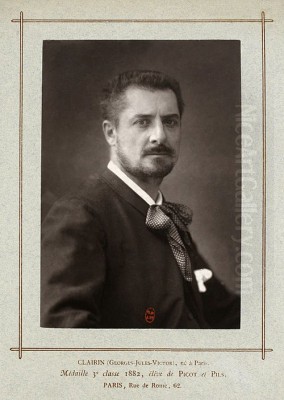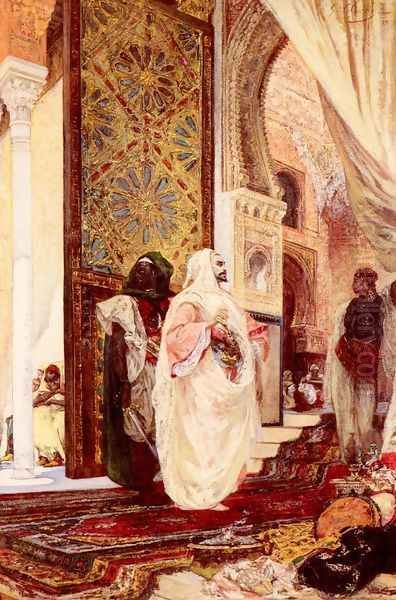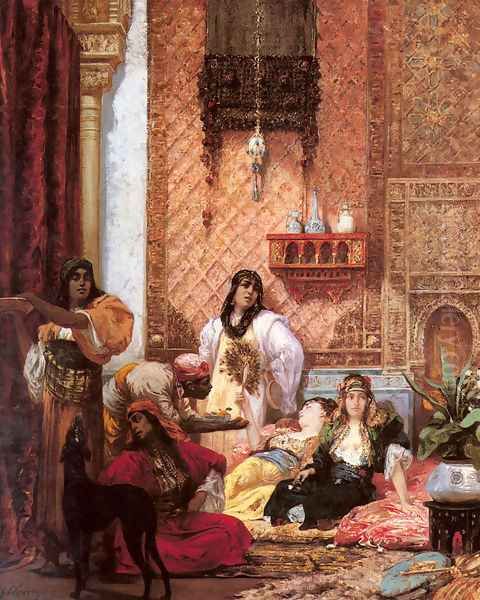
Georges Jules Victor Clairin stands as a significant figure in late 19th and early 20th-century French art. Born in Paris in 1843 and passing away in the seaside commune of Saint-Pair-sur-Mer in 1919, Clairin's life spanned a period of immense artistic change and cultural dynamism in France. He is primarily celebrated as a leading Orientalist painter and a skilled illustrator, whose work captured both the allure of distant lands and the vibrant social tapestry of Parisian life, particularly its theatrical circles. His legacy is intertwined with his exotic depictions of North Africa, his decorative public works, and his close association with the legendary actress Sarah Bernhardt.
Early Life and Academic Foundations
Georges Clairin's artistic journey began formally in Paris, the undisputed center of the art world in the 19th century. In 1861, he gained admission to the prestigious École des Beaux-Arts, the cornerstone of academic art training in France. There, he honed his skills under the tutelage of two notable masters: François-Édouard Picot and Isidore Pils. Picot was a respected painter known for his historical and mythological subjects, firmly rooted in the Neoclassical tradition passed down from Jacques-Louis David. Pils, himself a student of Picot and winner of the coveted Prix de Rome in 1838, was renowned for his military scenes and religious paintings, bringing a certain realism and dramatic flair to academic conventions.
Under their guidance, Clairin received a rigorous grounding in drawing, composition, and painting techniques. This academic training provided him with the technical proficiency that would underpin his entire career, even as his thematic interests evolved. During his studies, he formed important friendships, notably with Henri Regnault, another highly talented painter destined for fame, though his life would be tragically cut short. Together, Clairin and Regnault even shared a studio for a time, fostering a collaborative and stimulating environment for their early artistic development. Clairin made his debut at the influential Paris Salon in 1866, marking the beginning of a long and consistent exhibiting career.
The Lure of the Orient: Travels and Inspiration

Like many artists of his generation, Clairin was captivated by the perceived exoticism and vibrant cultures of lands beyond Europe. The Orient, a term broadly encompassing North Africa, the Middle East, and sometimes parts of Asia, held a powerful fascination for the Western imagination, fueled by colonial expansion, travel literature, and a romantic desire for the picturesque and unfamiliar. Clairin fully embraced this trend, becoming a key figure in the Orientalist movement. His travels were not mere touristic excursions but extended periods of immersion that profoundly shaped his artistic vision.
A pivotal journey occurred in 1868 when Clairin traveled to Spain with his friend Henri Regnault. Spain, particularly Andalusia, with its rich legacy of Moorish architecture and distinct cultural traditions, served as a gateway to the Orient for many French artists. They were deeply impressed by the intricate designs of the Alhambra in Granada and the Alcázar of Seville, absorbing the aesthetics of Moorish art and architecture. This experience ignited Clairin's passion for non-European subjects and decorative styles, influencing his use of pattern, color, and architectural settings in subsequent works.
Following the Spanish sojourn, Clairin embarked on extensive travels throughout North Africa. He spent a significant period, reportedly around 18 months, in Morocco, journeying with official diplomatic missions and independently. He also visited Algeria and Egypt. These trips provided him with a wealth of firsthand material. He sketched local people, bustling markets, desert landscapes, and architectural details. He witnessed and documented cultural spectacles, such as the thrilling equestrian displays known as "fantasias," which became a recurring theme in his work, exemplified in paintings like Battle of Arabs. His North African experiences infused his art with authenticity, vibrant color palettes, and a sense of atmospheric richness.
The Painter of Sarah Bernhardt
Perhaps one of the most defining aspects of Georges Clairin's career was his enduring friendship and artistic collaboration with the iconic French actress Sarah Bernhardt. Their relationship began in the Parisian social milieu and spanned an incredible fifty years, lasting until Clairin's death. Bernhardt was more than just a muse; she was a close confidante and a powerful patron. Clairin became, in many ways, her unofficial court painter, capturing her in numerous portraits both in her stage roles and in private life.

These portraits are among Clairin's most famous works. He depicted Bernhardt in character for celebrated plays such as Victor Hugo's Ruy Blas, Edmond Rostand's La Princesse Lointaine, and embodying historical figures like Cleopatra. These paintings were not mere likenesses; they captured the theatricality, charisma, and dramatic intensity that made Bernhardt a global superstar. Clairin skillfully used costume, pose, and setting to convey the essence of her stage personas. His intimate knowledge of the actress allowed him to portray her with a unique blend of public glamour and personal insight. This long association cemented Clairin's position within the vibrant cultural life of the Belle Époque.
Beyond formal portraits, Clairin also contributed illustrations related to Bernhardt's productions and public image. His work helped shape the visual identity of the "Divine Sarah," contributing to her legendary status. This connection to the theatre world extended beyond Bernhardt, as Clairin also produced illustrations depicting actors and costumes, demonstrating his keen interest in the performing arts.
Masterpieces and Major Themes
Georges Clairin's oeuvre is diverse, encompassing portraits, genre scenes, historical subjects, and large-scale decorative works, often unified by his distinctive style and thematic interests. His Orientalist paintings remain central to his reputation. Works like The Flourishing City of Egypt, Peace, exhibited at the Salon of 1913 to considerable acclaim, exemplify his approach. This painting depicts a serene, idealized vision of Egyptian life, featuring figures in traditional attire, camels, donkeys, and lush vegetation against a backdrop of ancient architecture, all rendered with rich color and meticulous detail. It embodies the romanticized, harmonious view of the East popular at the time.
His fascination with dynamic action, often inspired by his Moroccan travels, is evident in paintings depicting the "fantasia." These works, such as Battle of Arabs or Entering the Harem, capture the energy and spectacle of North African equestrian displays and imagined scenes of local life. They are characterized by swirling movement, dramatic compositions, and a focus on the elaborate costumes and weaponry of the riders.
Clairin also tackled historical and allegorical subjects. His painting Funeral of Victor Hugo - the vigil under the triumphal arch (1885) is a notable example, showcasing his ability to handle complex multi-figure compositions and capture a specific historical moment with atmospheric sensitivity, particularly his handling of light and shadow in the nocturnal, rain-swept scene. Another work, SICK WOMEN BEING REMOVED FROM VENICE, executed in watercolor and graphite, reveals a different facet of his art, addressing themes of suffering and historical drama, possibly referencing Venice's history with plagues.

His skills extended to large-scale decorative commissions. He contributed significantly to the opulent decoration of the Palais Garnier, the Paris Opéra house designed by Charles Garnier. Clairin painted panels for the ceiling of the Grand Foyer, completed around 1874, contributing to one of the most lavish public interiors of the era. He was also commissioned for decorative work for other public buildings and private patrons, including designs associated with the composer Camille Saint-Saëns in 1895. A work titled Segoura Fine Art was notably donated by the artist in 1904 for a charity auction benefiting soldiers wounded in war, described as symbolizing the awakening of the human spirit.
Style, Technique, and Orientalism
Clairin's artistic style is a compelling blend of academic precision and romantic sensibility, filtered through the lens of Orientalism. His training at the École des Beaux-Arts provided him with a strong foundation in draftsmanship and composition, evident in the clear structure and detailed rendering of his works. However, he moved beyond the often rigid constraints of pure academicism, embracing the vibrant colors, dramatic light effects, and exotic subject matter characteristic of the Orientalist movement.
His palette became noticeably brighter and more varied after his travels, reflecting the intense light and colorful textiles of North Africa and Spain. He skillfully employed light and shadow not just for modeling form but also for creating mood and atmosphere, whether depicting the sun-drenched landscapes of Morocco or the gaslit interiors of Parisian theatres. His paintings are often characterized by a richness of detail, particularly in the rendering of fabrics, ornamentation, and architectural elements, reflecting the influence of Moorish design and his fascination with decorative surfaces.
As an Orientalist, Clairin participated in a broader European artistic and cultural phenomenon. Like his contemporaries Jean-Léon Gérôme, Eugène Fromentin, and Gustave Guillaumet, he sought inspiration in the cultures of North Africa and the Middle East. While sometimes criticized today for perpetuating stereotypes or presenting a romanticized, occasionally inaccurate, view of these regions, his work undeniably captured the Western fascination with these cultures. Compared to the earlier, more Romantic Orientalism of Eugène Delacroix or Théodore Chassériau, Clairin's work often exhibits a greater degree of ethnographic detail, though still filtered through a European aesthetic sensibility. His focus often leaned towards the picturesque, the ceremonial, and the theatrical aspects of the cultures he depicted.
Contemporaries and Artistic Context
Georges Clairin operated within a rich and complex artistic landscape in late 19th-century Paris. His teachers, Picot and Pils, represented the established academic tradition, a lineage that included dominant figures like Alexandre Cabanel and William-Adolphe Bouguereau, whose polished, idealized works were highly favored by the official Salon. Clairin, while trained in this system, carved his own niche with his Orientalist themes and theatrical portraits.
His friendship and travels with Henri Regnault place him alongside one of the most promising talents of his generation, whose work also showed Orientalist influences before his untimely death in the Franco-Prussian War. Within the Orientalist sphere, Clairin's work can be compared to that of Jean-Léon Gérôme, known for his highly detailed, almost photographic depictions of Middle Eastern scenes, or Eugène Fromentin, who specialized in Algerian landscapes and equestrian subjects. Gustave Guillaumet offered a perhaps more sober, less romanticized view of Algerian life.
In the realm of portraiture and depictions of modern life, Clairin's work intersects with that of artists like James Tissot and the Italian expatriate Giovanni Boldini, who also captured the elegance and dynamism of Belle Époque society, though often with a different stylistic flair. Clairin's focus on Sarah Bernhardt connects him directly to the world of theatre, a subject also explored by contemporaries like Edgar Degas, albeit with a focus on the ballet and the more unglamorous aspects of backstage life. Clairin's engagement with major cultural figures like Victor Hugo (as a subject) and Camille Saint-Saëns (as a collaborator) further underscores his integration into the artistic and intellectual currents of his time.
Exhibitions and Recognition
Throughout his long career, Georges Clairin was a regular and recognized presence in the Parisian art world. Starting with his debut in 1866, he frequently exhibited his paintings at the annual Paris Salon, the most important venue for artists seeking official recognition and patronage. His works, particularly his portraits of Sarah Bernhardt and his vibrant Orientalist scenes, were often well-received by critics and the public, attracting considerable attention.
His contributions to major public projects, most notably the ceiling decorations for the Paris Opéra's Grand Foyer, brought his work to a wide audience and solidified his reputation as a capable decorative painter. The importance of such commissions in 19th-century France cannot be overstated, as they represented significant official endorsement.
In recognition of his artistic achievements and contributions to French culture, Georges Clairin was awarded the prestigious Légion d'honneur (Legion of Honour), France's highest order of merit. This award signified his standing within the artistic establishment of the Third Republic. His consistent participation in Salons organized by the Société des Artistes Français further demonstrated his active role in the official art structures of the period.
Legacy and Influence
Georges Clairin left behind a substantial body of work that continues to attract interest from art historians, collectors, and the public. He is remembered primarily as a prominent Orientalist painter whose travels provided rich inspiration for works filled with color, detail, and exotic allure. His paintings offer valuable, if sometimes romanticized, visual documents of the 19th-century European fascination with North Africa and the Middle East.
His numerous portraits of Sarah Bernhardt constitute a unique artistic record of one of history's greatest actresses. These works transcend mere portraiture, capturing the essence of theatrical performance and celebrity in the Belle Époque. They remain iconic images associated with Bernhardt and the era she dominated.
While perhaps not as revolutionary as the Impressionists or Post-Impressionists who were his contemporaries, Clairin successfully navigated the established art system while developing a distinctive personal style. His technical skill, combined with his popular subject matter, ensured his success during his lifetime. His influence can be seen in the continuation of Orientalist themes by later artists and in the tradition of theatrical portraiture. His works are held in numerous museums in France and abroad, including the Musée d'Orsay and the Petit Palais in Paris. Furthermore, the reproduction of his popular works through prints helped disseminate his images to a wider audience, contributing to his lasting recognition.
Conclusion
Georges Jules Victor Clairin was an artist perfectly attuned to his time. Rooted in the academic tradition, he embraced the popular fascination with Orientalism, using his extensive travels to inform vibrant and detailed depictions of North Africa. His long and fruitful relationship with Sarah Bernhardt placed him at the heart of Parisian cultural life, resulting in some of the most memorable theatrical portraits of the era. Through his paintings, illustrations, and decorative works, Clairin crafted a visually rich chronicle of both distant lands and the dazzling society of the Belle Époque. He remains an important figure for understanding the complexities of French art in the late 19th and early 20th centuries, representing a successful synthesis of academic skill, exotic subject matter, and engagement with the contemporary world.